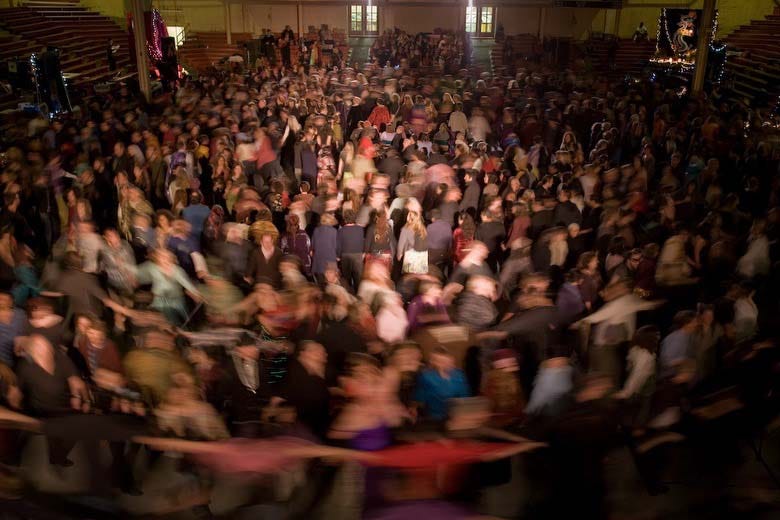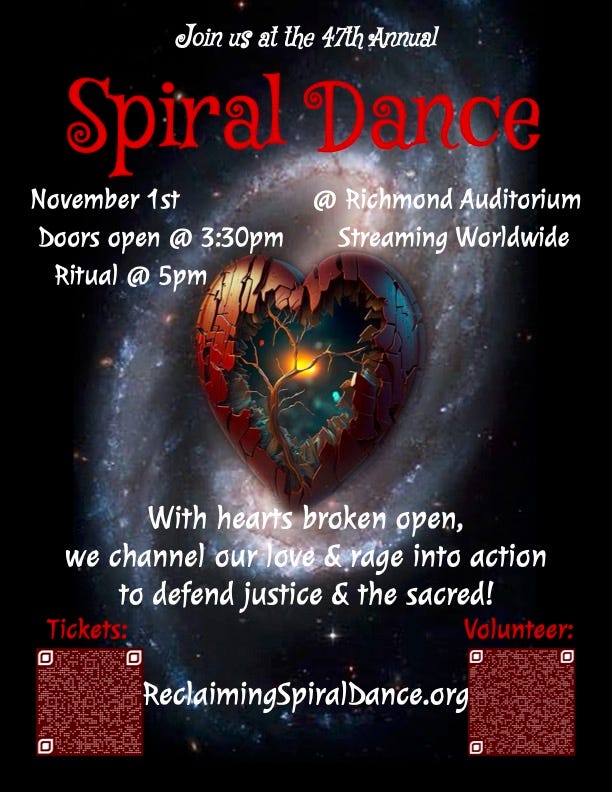This week we’re busy preparing for our Spiral Dance Ritual, that we create every year for Samhain, the ancient Celtic festival that in popularly known as Halloween. (Click the link if you want information on how to come or watch the livestream). It’s our biggest, most elaborate ritual of the year, and it’s a tradition we’ve carried on since 1979, when under the guise of throwing a book party for my the first published book, The Spiral Dance: A Rebirth of the Ancient Religion of the Goddess, we threw an extravaganza of a ritual for two nights, with a chorus, elaborate costumes, ceramic headdresses and our first attempt to dance a spiral with several hundred people.
Since then we’ve carried on the tradition in many different ways. Some years, we’ve had aerial dancers invoking the elements. Before the big WTO demonstrations in 1999, we invoked the Activist Goddess with a banner hang, and the altars included an ice sculpture spelling out WTO which melted during the course of the ritual. In the ‘90s, for a time we did three linked rituals over three nights—we were younger then! During Covid, we did the ritual online, then outdoors during daytime for two years.
Leading several hundred people, sometimes over a thousand, into a double spiral that winds around itself and winds back again so that everyone sees everyone else and can look into their eyes is always a magical and practical challenge. At times, its turned into a giant tangle, but over the years we learned some tricks to get a crowd in trance into a complex formation. The effort has made me really good at untangling cords and string! And the sense of common power and connection when those thousand people lift their voices in unison to raise a cone of power is both ecstatic and transformative.
But at this particular moment, when the very foundations of our democracy are under assault, is there justification for devoting so much time and energy to ritual and ceremony? Can ritual fight fascism?
I believe it can. Not necessarily as directly as we might wish: the ICE thugs will not suddenly stop and say, “Oh no, what are we doing?” But ritual does something else. It strengthens that sense of community and interconnectedness that fascism seeks to rupture.
When we participate in a ritual or ceremony, we know that we belong to something larger than ourselves, and we achieve that sense of belonging without making some other group the ‘other’, those who don’t belong. We feel a sense of common purpose and support that is tangible, and we are moved by the beauty and inspiration that comes from our community and from those great forces of birth, growth, death and regeneration that move through the world. We draw strength from the struggles of the ancestors and hope for the world of our descendants.
Samhain is the time when we believe that the veil is thin that divides the worlds of the seen and the unseen, the living and the dead. At this time of year, we remember and commune with those who’ve gone before us, our Beloved Dead, our ancestors, and our spiritual ancestors. We can call on them for help and inspiration in our current struggles.
When we create each year’s Spiral Dance, we first begin meeting in the winter or spring to meditate, vision and craft our in tension. Each year’s ritual follows certain traditional patterns: we ground, we invoke the elements, we honor Goddess and Gods along with the ancestors and the Beloved Dead, we take a trance journey to the Shining Isle where we can, at least in our imagination, meet with those who’ve gone before and ask for help, and we dance the spiral to raise power for regeneration and renewal. But each year we also have a specific intention around which we craft elements of the ritual.
This year the intention is: “With hearts broken open, we channel our love and rage into action to defend democracy and the sacred.”
The focus this year will be to acknowledge the losses and the heartbreak we feel. For some of us this, may be personal–we’ve lost friends, relations, loved ones. But for all of us, it is also collective–we’ve lost rights, we’ve lost confidence in our democratic institutions, we are deeply affected by the immense suffering we see all around us, by the violence, callousness and cruelty of the wars and policies that target the vulnerable. A ritual gives us a moment to experience that loss with others who can offer comfort and support. But our intention is not to just grieve, but to transform sadness and anger into the positive action we so desperately need at this time to defend justice and all that is sacred.
The art of ritual, like many ,forms of art is to turn abstraction into sensation. Poet William Carlos Williams said “No ideas, but in things”. So in this ritual, the plan is to give people a chance to grieve and share their heartbreaks as we rip cloth, like the ancient practice of tearing our garments as a symbol of mourning. Then we’ll take those strips of cloth, tie them together, crochet them into cords and sew them on to a banner that we can take into demonstrations and marches.
Ritual is where the mystical meets the logistical, so I’ve been spending much time this past week ripping fabric into panels and notching them so they can easily be torn into the proper size strips. There are a thousand nonspiritual details to consider in putting on a present-day ritual, from the venue’s requirement that we hire security guards to the QR codes on the website not working. It feels far from the process of prayerfully gathering herbs singing boulders up into henges. But all those mundane details are part of the ritual, acts of service and love.
Nine years ago, after Trump’s first election, I went to Standing Rock, to the big mobilization there against the Dakota Access Pipeline that threatened traditional lands and ancestral burial sites. The protest had been going on all summer long, and it became the largest gathering of indigenous people in modern times. It coincided with a challenging period in my own life that made it impossible for me to go until Thanksgiving weekend. But it was a transformative experience for me.
I’d spent a lifetime advocating that spiritual and the political are not separate, that both deal with our core values, with the deep questions of our meaning and purpose in life. We need some kind of spiritual base and community to withstand the rigors of a life of activism, the many defeats and the real personal risks and dangers. When I arrived at the encampment the first thing I saw was a sign over the gate that said “Here you enter a place of prayer and ceremony. “
Prayer and ceremony were integrated into every aspect of the encampment. We began each day with morning prayers at the river. A sacred fire burned in the central meeting place, and other sacred fires burned the center of various camps. Every action, every strategy, was prayed about, and that Sunday elders Cheryl Angel and LaDonna Brave Bull led us in a women’s action to make offerings at the river on the front lines of the blockade.
For me it was a tremendous affirmation that I was not alone in thinking that the spiritual/ political split was itself a symptom of the colonial mindset, that prayer and ceremony and a spiritual base kept indigenous communities alive through suffering, genocide and devastating loss. Communal spiritual practice can be a key to strengthening resilience, our ability to withstand disturbances and assaults.
One more story, one that I heard when I was invited to an academic conference in Brazil some years ago. A group of anthropologists had visited a remote tribe that had been devastated by disease, colonial incursions and alcoholism. Fifteen years later, they came back and discovered that the tribe was rebounding. People were healing, they had revived ancient ceremonies and were strengthening their resistance to land grabs and exploitation. when they asked what happened, they were told that a group of strangers had come through and brought ayahuasaca. They held ceremonies, and the ancestors appeared and gave them back their rituals and traditions which had been abandoned and forgotten. Now they were practicing again, and the community was restored.
Ohlone elder Anne Marie Sayers, always says when ritual song and ceremony stop the people die. Ritual alone won’t turn back the tide of fascism, but it can help strengthen our sense of connection, coherence and commitment to take the actions that will.
If you’re in the Bay Area you can join us on November 1st at the Richmond Memorial Auditorium for the Spiral Dance. if you’re not, you can watch it live streamed.
On November 2, you can take part in the beautiful Festival of Altars put on by the Marigold Project to celebrate El Dia de los Muertos, the Day of the Dead. Every year there’s a huge procession through the streets of the Mission District honoring the dead, drawing on the traditions of the Latin(X) community and one that has become a beloved part of our city culture and a living example of the beauty and enrichment that cultural diversity brings to our lives.
Or you could create a simple family ritual of your own: make a dinner with the traditional foods that come from your heritage, bring out the photograph albums, and tell the family stories that might otherwise be lost.
Wherever you are I encourage you to find or create the rituals and the ceremonies at this time of year that can help you feel more deeply connected to your ancestors, to your heritage, to your community, and to our collective responsibility to create a world of justice and beauty for those to come.
See here for more information and tickets. Tickets also available at the door!
(I keep my posts free for all to read, but if you upgrade to a paid subscription, you will be supporting my writing and activism, and gain access to monthly community conversations and other benefits.)
This post has been syndicated from Starhawk’s Substack, where it was published under this address.


